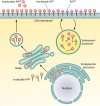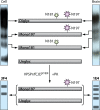Prions: Beyond a Single Protein
- PMID: 27226089
- PMCID: PMC4978610
- DOI: 10.1128/CMR.00046-15
Prions: Beyond a Single Protein
Abstract
Since the term protein was first coined in 1838 and protein was discovered to be the essential component of fibrin and albumin, all cellular proteins were presumed to play beneficial roles in plants and mammals. However, in 1967, Griffith proposed that proteins could be infectious pathogens and postulated their involvement in scrapie, a universally fatal transmissible spongiform encephalopathy in goats and sheep. Nevertheless, this novel hypothesis had not been evidenced until 1982, when Prusiner and coworkers purified infectious particles from scrapie-infected hamster brains and demonstrated that they consisted of a specific protein that he called a "prion." Unprecedentedly, the infectious prion pathogen is actually derived from its endogenous cellular form in the central nervous system. Unlike other infectious agents, such as bacteria, viruses, and fungi, prions do not contain genetic materials such as DNA or RNA. The unique traits and genetic information of prions are believed to be encoded within the conformational structure and posttranslational modifications of the proteins. Remarkably, prion-like behavior has been recently observed in other cellular proteins-not only in pathogenic roles but also serving physiological functions. The significance of these fascinating developments in prion biology is far beyond the scope of a single cellular protein and its related disease.
Copyright © 2016, American Society for Microbiology. All Rights Reserved.
Figures






Similar articles
-
Prion encephalopathies of animals and humans.Dev Biol Stand. 1993;80:31-44. Dev Biol Stand. 1993. PMID: 8270114 Review.
-
[Biology of non-conventional transmissible agents or prions].Rev Neurol (Paris). 1998 Feb;154(2):142-51. Rev Neurol (Paris). 1998. PMID: 9773035 Review. French.
-
Immunoaffinity purification and neutralization of scrapie prions.Prog Clin Biol Res. 1989;317:583-600. Prog Clin Biol Res. 1989. PMID: 2574871 Review.
-
Prion diseases of the central nervous system.Monogr Pathol. 1990;(32):86-122. Monogr Pathol. 1990. PMID: 2192281 Review.
-
Molecular biology of prions causing infectious and genetic encephalopathies of humans as well as scrapie of sheep and BSE of cattle.Dev Biol Stand. 1991;75:55-74. Dev Biol Stand. 1991. PMID: 1686599 Review.
Cited by
-
Further Characterization of Glycoform-Selective Prions of Variably Protease-Sensitive Prionopathy.Pathogens. 2021 Apr 23;10(5):513. doi: 10.3390/pathogens10050513. Pathogens. 2021. PMID: 33922765 Free PMC article.
-
Characterization of Anchorless Human PrP With Q227X Stop Mutation Linked to Gerstmann-Sträussler-Scheinker Syndrome In Vivo and In Vitro.Mol Neurobiol. 2021 Jan;58(1):21-33. doi: 10.1007/s12035-020-02098-8. Epub 2020 Sep 5. Mol Neurobiol. 2021. PMID: 32889654 Free PMC article.
-
Upregulated PrPC by HBx enhances NF-κB signal via liquid-liquid phase separation to advance liver cancer.NPJ Precis Oncol. 2024 Sep 27;8(1):211. doi: 10.1038/s41698-024-00697-5. NPJ Precis Oncol. 2024. PMID: 39333690 Free PMC article.
-
In Vitro Seeding Activity of Glycoform-Deficient Prions from Variably Protease-Sensitive Prionopathy and Familial CJD Associated with PrPV180I Mutation.Mol Neurobiol. 2019 Aug;56(8):5456-5469. doi: 10.1007/s12035-018-1459-0. Epub 2019 Jan 5. Mol Neurobiol. 2019. PMID: 30612334 Free PMC article.
-
In silico analysis of fungal prion-like proteins for elucidating their role in plant-fungi interactions.Arch Microbiol. 2024 Jun 19;206(7):308. doi: 10.1007/s00203-024-04040-1. Arch Microbiol. 2024. PMID: 38896139
References
-
- Wickner RB. 2005. Scrapie in ancient China? Science 309:874. - PubMed
-
- Cuille J, Chelle PL. 1936. Pathologie animale—la maladie dite tremblante du mouton est-elle inoculable? CR Hebd Seances Acad Sci 203:1552–1554.
Publication types
MeSH terms
Substances
Grants and funding
LinkOut - more resources
Full Text Sources
Other Literature Sources

